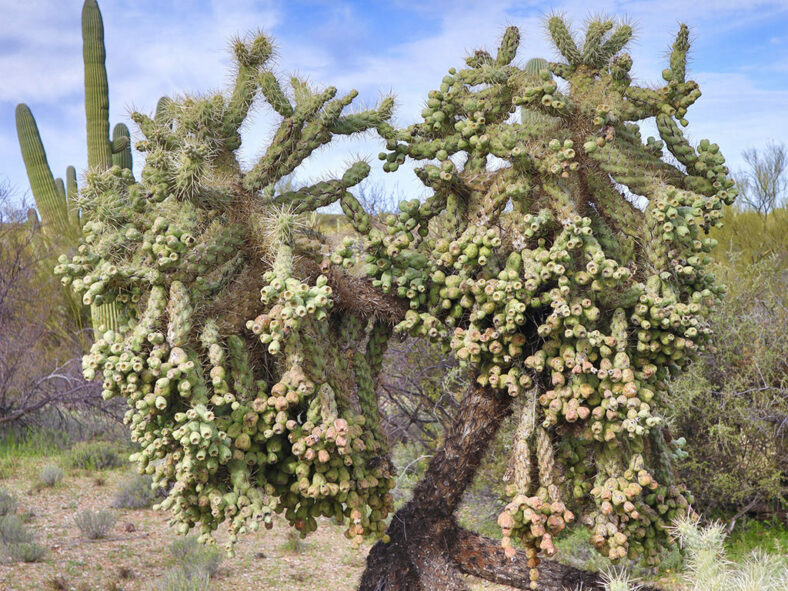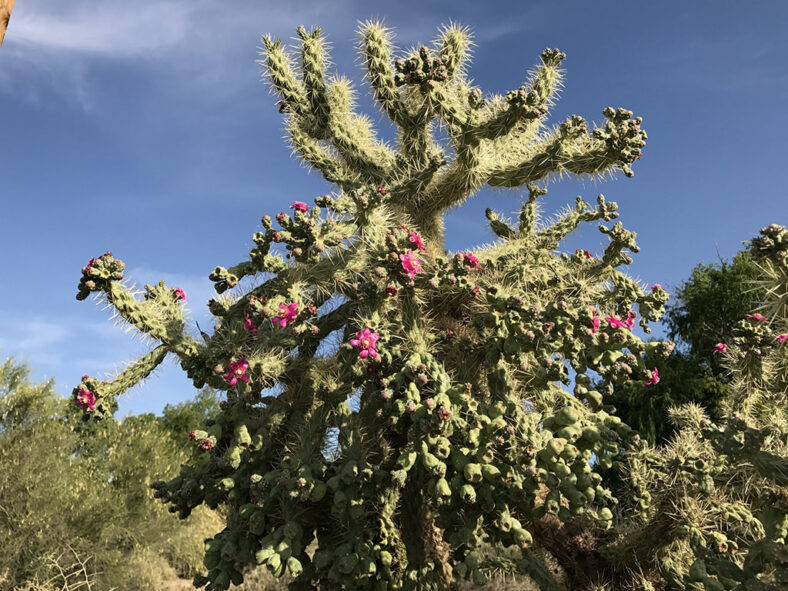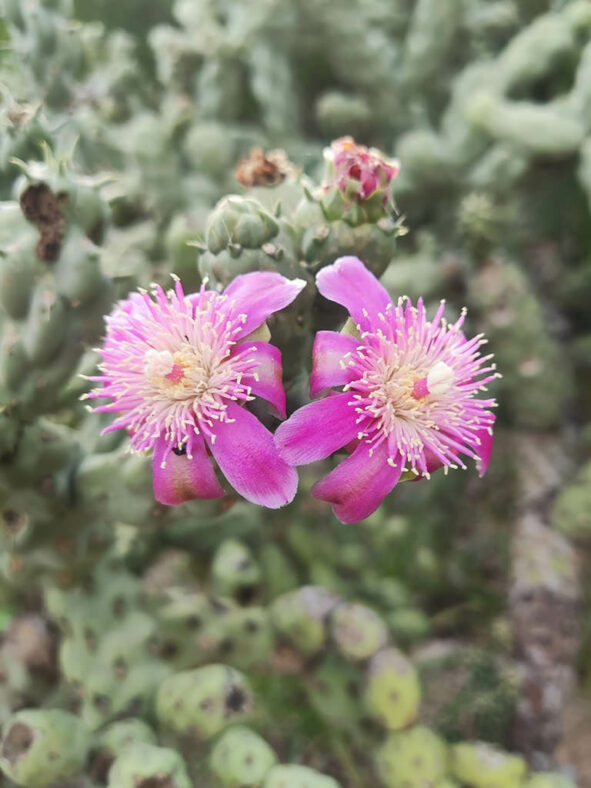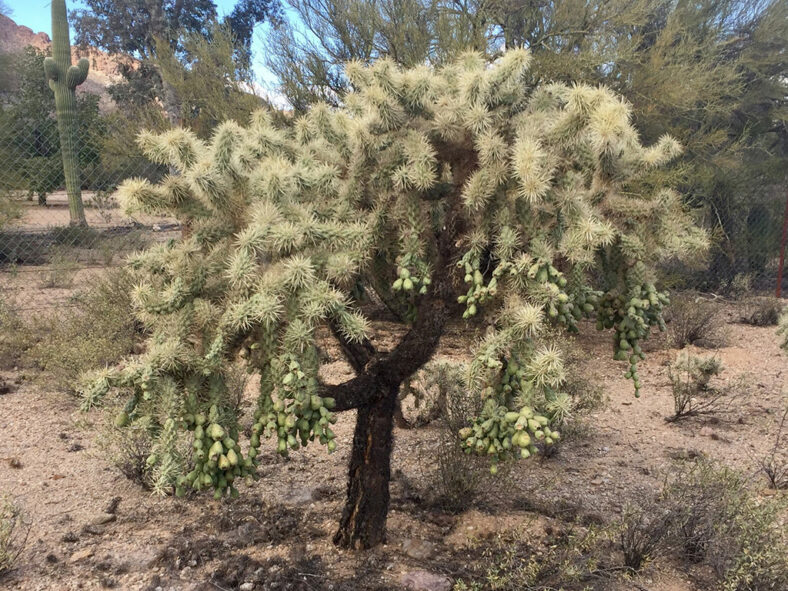Cylindropuntia fulgida is commonly known as the Jumping Cholla because its stem segments can easily detach and attach themselves to human clothing or even desert animals when physically disturbed.
Scientific Name
Cylindropuntia fulgida (Engelm.) F.M.Knuth
Common Name(s)
Boxing Glove Cactus, Boxing Glove Cholla, Chain Fruit Cholla, Club Cactus, Hanging Chain Cholla, Jumping Cholla, Sonoran Jumping Cholla
Synonym(s)
Cylindropuntia fulgida var. fulgida, Grusonia fulgida, Opuntia fulgida
Scientific Classification
Family: Cactaceae
Subfamily: Opuntioideae
Tribe: Cylindropuntieae
Genus: Cylindropuntia
Etymology
The specific epithet "fulgida (FUL-jih-duh)" means "flashing, glittering, shining" and refers to the silvery, shiny appearance of the spine sheaths.
Origin
Cylindropuntia fulgida is native to the United States (California and Arizona) and Mexico (Sonora, Sinaloa, and Baja California). It grows in Sonoran desert scrub, sandy flats, rocky slopes, and rolling hillsides at elevations ranging from 985 to 3610 feet (300 to 1,100 m). Outside its native range, this plant is recorded as invasive in Australia, the Pacific Islands, and South Africa.
Description
Cylindropuntia fulgida is a tree-like cactus with a woody trunk and a crown of many-branched segmented stems. It can grow up to 10 feet (3 m) tall. The stem segments are gray-green and covered with yellowish or sometimes pale pinkish spines that darken to brown. They are cylindrical with broadly oval tubercles and can measure up to 9.2 inches (23 cm) long and 1.4 inches (3.5 cm) wide. The terminal segments of each stem are easily detached. The spines are interlaced with spines of adjacent areoles, forming a dense layer that obscures the stem. They can grow up to 1.2 inches (3 cm) long and are present on most areoles in clusters of up to 18, but usually 6 to 12. The spines are enclosed in baggy, papery, light-yellow sheaths, which give the stem segments a whitish appearance. The areoles are gold to tan and become gray or black as they mature. The glochids are yellow and can be found in an adaxial tuft and sometimes scattered along the margins of areoles.
During spring and summer, Cylindropuntia fulgida produces pink to magenta flowers that open in the late afternoon. The flowers appear at the tips of the terminal stem segments or old fruits and can reach up to 0.6 inches (1.5 cm) in diameter. The proliferating fruits form long, branching, pendent chains. They are inverted cone-shaped, shallowly tuberculate, usually spineless, gray-green at maturity, and can grow up to 2.2 inches (5.5 cm) long and 0.9 inches (2.3 cm) in diameter. The fruits contain pale yellow to brownish seeds.

How to Grow and Care for Cylindropuntia fulgida
Light: Cylindropuntia fulgida thrives in full sun, but some shade during midday and afternoon can prevent sunburn in hot climates. When grown indoors, a window that receives sunlight for 6 hours a day works best.
Soil: This cactus requires a soil mix that drains well. So, use a commercial cactus potting mix or create your own.
Temperature: Extremely tolerant of high temperatures, Cylindropuntia fulgida prefers cooler temperatures in winter. It grows best in USDA Plant Hardiness Zones 8b to 10b, with average minimum winter temperatures ranging from 15 to 40 °F (-9.4 to 4.4 °C).
Watering: From spring to fall, water moderately and let the soil dry out completely before watering again. In most areas, rainfall will be enough for established plants. If potted, never let the container sit in water. During the winter, suspend the watering.
Fertilizing: Cylindropuntia fulgida does not need fertilizer when planted in the ground. However, it will benefit from fertilizing during the growing season when grown in a container. Apply a water-soluble fertilizer. Suspend feeding during the winter when the plant goes dormant.
Repotting: Repot only when the cactus becomes potbound or is too large and unstable in its container. Choose a slightly larger container with drainage holes at the bottom. The best time for repotting is late winter or early spring.
Propagation: You can propagate Cylindropuntia fulgida by stem segments or seeds. Using stem segments is the easiest method and yields faster results. For best results, remove segments in early summer and sow the seeds in late spring.
Learn more at How to Grow and Care for Opuntia.
Toxicity of Cylindropuntia fulgida
Cylindropuntia fulgida is not toxic to humans or pets. However, be careful when around it and try to avoid touching it.
Forms of Cylindropuntia fulgida
Links
- Back to genus Cylindropuntia
- Succupedia: Browse succulents by Scientific Name, Common Name, Genus, Family, USDA Hardiness Zone, Origin, or cacti by Genus
Photo Gallery
Click on a photo to see a larger version.


